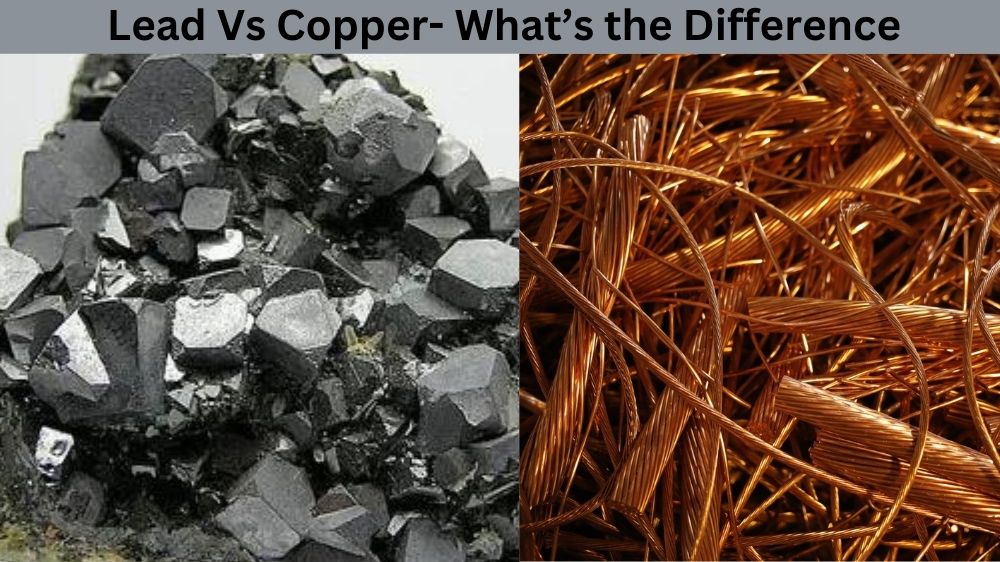
Lead Vs Copper- What’s the Difference
Whether we realize it or not, metals are essential components in our daily lives. Some metals, like copper and lead, are widely used to produce various items we use daily, such as coins, electrical wires, and pipes. Lead and copper are two different metals with varying properties. In this post, we will discuss the differences between lead and copper.
What is Lead?
Lead is a chemical element with the symbol Pb (from Latin: Plumbum) and atomic number 82. It is a soft, malleable, and ductile metal with a blue-greyish colour when freshly cut. Lead has a relatively low melting point of 327°C (621°F). It is not easily attacked by acids except hydrofluoric acid. Still, it can be oxidized by air or water to form oxides of lead which have various colours depending on the degree of oxidation. It appears white When finely divided, coarsely weathered, and greyish brown. Historically, Lead has been used for many uses in construction, pipes, ammunition, weights for balances scales and even currency! In addition to its malleability and corrosion resistance, lead also has several useful characteristics, including sound absorption and radiation protection, because its density allows for a great mass-per-volume ratio providing for improved barrier capacity against x-rays and gamma rays.
What Is Copper?
Copper is a ductile, malleable reddish-orange metal that is an excellent thermal and electrical conductor. It’s found naturally occurring in the earth’s crust and can be extracted from ores such as chalcopyrite, Bornite, Chalcocite, Malachite, Azurite, and Tetrahedrite. Not only does it have many uses in industry, but it also has medicinal properties due to its anti-microbial effects. It’s been used for centuries worldwide by civilizations for healing wounds and creating sculptures, some of which have survived. It is essential for vital organs such as the heart, brain, kidneys, liver, and gall bladder. Copper also plays a role in helping regulate cholesterol levels along with being important for glycolysis which processes sugar into energy required by cells throughout our body.
For more information visit Kapilsteel.com
Difference Between Lead And Copper
Physical properties
One notable difference between lead and copper is their physical properties. Copper is a reddish-brown metal that is highly malleable and ductile, making it ideal for jewellery, electrical wires, and pipes. Lead, on the other hand, has a bluish-white colour that is soft and malleable. Lead is also highly toxic, making it a risk to environmental and public health when improperly handled.
Chemical properties
Another difference between lead and copper is their chemical properties. Copper is a highly conductive metal not reactive to water or air, making it ideal for electrical wires and plumbing. Conversely, lead is a dense metal that corrodes quickly when exposed to water or air. It’s not ideal for any use involving water or air exposure.
Health risks
Lead has been banned in many countries because of its adverse effects on health. Prolonged exposure to lead can lead to serious health conditions such as brain damage, kidney damage, and reproductive problems. On the other hand, copper is generally considered safe for humans, even in large amounts.
Importance to society
Both lead and copper have played significant roles in human societies for thousands of years. Copper, for instance, is used to make coins, electrical wires and is essential for the construction industry. On the other hand, although lead has been phased out of many industries, it remains useful for lead-acid batteries, bullets, and some specialty metal alloys.
Pricing
The pricing of copper and lead also differ significantly. Copper is an expensive metal due to its high demand. On the other hand, lead is relatively cheaper than copper. The difference in pricing is based on factors such as supply and demand, availability, and the type of industry that utilizes these metals.
Conclusion:
In conclusion, lead and copper are different metals in their chemical and physical properties, health risks, societal application, and pricing. While copper is an important metal for various industries, from electrical wiring to construction, lead is hazardous to the environment and human health. It has mostly been phased out in many industries. Understanding these differences is critical to use these metals correctly and responsibly.